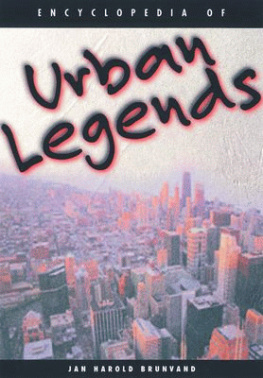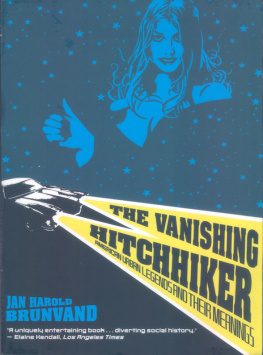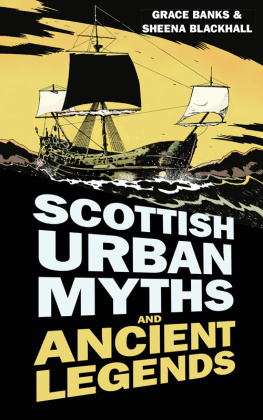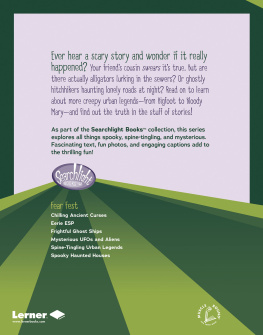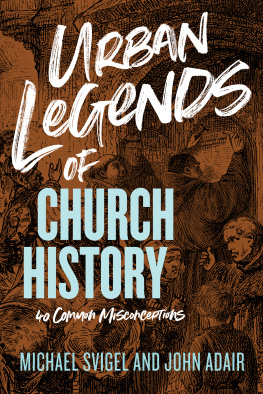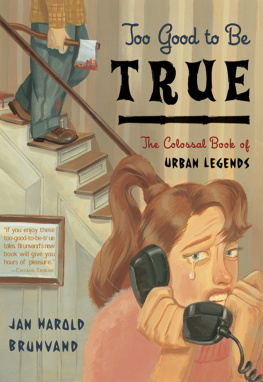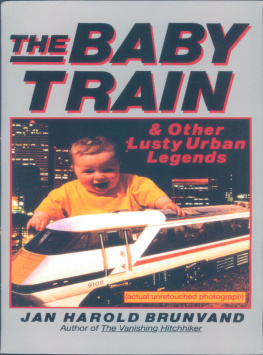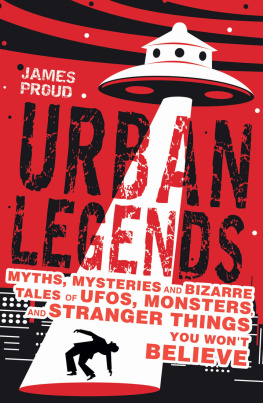

Encyclopedia of Urban Legends
Too Good to Be True
The Truth Never Stands in the Way of a Good Story
American Folklore: An Encyclopedia
The Baby Train
Curses! Broiled Again!
The Mexican Pet
The Choking Doberman
The Vanishing Hitchhiker
The Study of American Folklore
Readings in American Folklore
CONTENTS

B efore radio and television, long before the Internet and e-mail, and even before there were folklorists around to collect them, rumors and legends circulated in urban settings, and they were sometimes noted and documented by journalists and other writers. These precursors to modern urban legendsoften horror storiescan sometimes even be traced back to ancient times, as were the accounts of supposed atrocities performed in the name of religion that folklorist Bill Ellis found to be just as lively in the streets of pre-Christian Rome as they are in New York or Chicago today (see Bill Ellis, De Legendis urbis: Modern Legends in Ancient Rome, Journal of American Folklore 96 [1983]: pp. 200208). The American author Nathaniel Hawthorne found an apt metaphor for such stories in his 1851 novel The House of the Seven Gables when in the opening chapter he described bloody rumors about a local murder as being typical of stories... which are sure to spring up around such an event... and which, as in the present case, sometimes prolong themselves for ages afterwards, like the toadstools that indicate where the fallen and buried trunk of a tree has long since mouldered into the earth. We must also credit Hawthorne with recognizing the role of media in circulating rumors and legends, for he wrote in the same chapter about Traditionwhich sometimes brings down truth that history has let slip, but is oftener the wild babble of the time, such as was formerly spoken at the fireside, and now congeals in newspapers....
Those who recorded precursors to urban legends, whether they reported them simply as weird news or transmuted them into creative fiction, invariably rewrote the stories instead of publishing the basic oral versions as told on the streets. The early writers paraphrased, retold, and sometimes wildly elaborated on these stories, adding specific names for characters, background details, atmospheric touches, and even commentary. Yet some writers, as in the first three stories in this chapter, conveyed the horror of a situation without burying it in sentimentality or opinion. Among the elaborated stories in this chapter, Alexander Woollcotts The Vanishing Lady is especially flowery, and Bennett Cerf s two New York City stories are not far behind. (I left out Carl Carmers well-known literary treatment of The Vanishing Hitchhiker as being overly melodramatic for modern tastes and thus hardly scary at all.) The report of Dr. S. Weir Mitchells first-person account of a ghost visitation and the claimed verbatim versions of the Corpse in the Car stories reported by Marie Bonaparte are much closer to the ideal of unvarnished texts now preferred by folklore scholars. At the end of the chapter I include examples of twentieth-century folkloristic and journalistic versions of Embalmed Alive and The Vanishing Hitchhiker as a transition to horror urban legends as they are usually told nowadays. I have also scattered a few more precursors among the modern legends in subsequent chapters.
The favorite scary urban legends of early writers tended to be supernatural (an uncommon trait in modern ULs), and the writers favored plots featuring corpses, cemeteries, damsels in distress, helpful strangers, devoted doctors and priests, gypsies, sudden deaths, insanity, nightmares, disease, and other such details. The settings tended to be lonely spots late at night, places with a dark and sometimes even romantic atmosphere and, if possible, with a hint of some terrible conspiracy. Yet, even in the earliest versions, there are previews of modern life in the mention of cars, hotels, elevators, the police, morticians, and the like. Some of the more traditional folkloristic details (or motifs, as folklorists call them) were prophecies, the identification of a ghost in a portrait, mysterious sudden disappearances, and remarkable events occurring on the anniversary of a death.
As with all folk narratives circulating in oral tradition, there are some rather odd details to be found in these legends. Note, for example, the reference to a prophetic ritual in the 1941 version of The Graveyard Wager, as well as those curious ten suitcases and ten coats left behind in the 1940 version of The Vanishing Hitchhiker. Still, in their essentials, these precursors anticipate modern ULs: they are often attributed to FOAFs, exist in several versions, are unverified although told as true, and tend to be localized, even if the same story is known in many other places. Indeed, most of these precursor legends continue to be told today as modern ULs, updated for the present. Nowadays, however, the style of narration is more concise, less emotional, and includes stark and often rather abrupt endings. A major component of the horror of these ULs lies in the style of oral performance (or, in the Internet versions, verbal skill), a feature you will largely have to imagine while reading them. My recommendation is that you retell the legends in your own style after you have read them on the antiseptic printed page.
The legends in this chapter span three centuries, starting with Daniel Defoes eighteenth-century journalistic treatment of plague stories and ending with twentieth-century versions of the classic ghost story The Vanishing Hitchhiker. We realize in reading the first story that Defoe had it exactly right over three centuries ago when he pointed out that the events described are always supposed to have happened locally, although not exactly where the teller lives, that their essential details remain fixed wherever they are told, and that there are few if any reliable details mentioned in the stories. Furthermore, just as the Russian reporters learned in 1890 (see the third story), it is futile to attempt to track down an original source, much less the truth about a rumor or legend. As Defoe put it, there was more of Tale than of Truth in those Things.
W e had at this Time a great many frightful Stories told us of Nurses and Watchmen, who looked after the dying People, that is to say, hird Nurses, who attended infected People, using them barbarously, starving them smothering them, or by other wicked Means, hastening their End, that is to say, murthering of them: And Watchmen being set to guard Houses that were shut up, when there has been but one person left, and perhaps, that one lying sick, that they have broke in and murthered that Body, and immediately thrown them out into the Dead-Cart! And so they have gone scarce cold to the Grave.
I cannot say, but that some such Murthers were committed, and I think two were sent to Prison for it, but died before they could be tryd; and I have heard that three others, at several Times, were excused for Murthers of that kind; but I must say I believe nothing of its being so common a Crime, as some have since been pleasd to say....
... as for murthers, I do not find that there was ever any Proof of the Facts, in the manner, as it has been reported, except as above.
They did tell me indeed of a Nurse in one place, that laid a wet Cloth upon the Face of a dying Patient, who she tended, and so put an End to his Life, who was just expiring before: And another that smotherd a young Woman she was looking to, when she was in a fainting fit, and would have come to her self: Some that killd them by giving them one Thing, some another, and some starved them by giving them nothing at all: But these Stories had two Marks of Suspicion that always attended them, which caused me always to slight them, and to look on them as meer Stories, that People continually frighted one another with. (1.) That wherever it was that we heard it, they always placed the Scene at the farther End of the town, opposite, or most remote from where you were to hear it: If you heard it in
Next page

